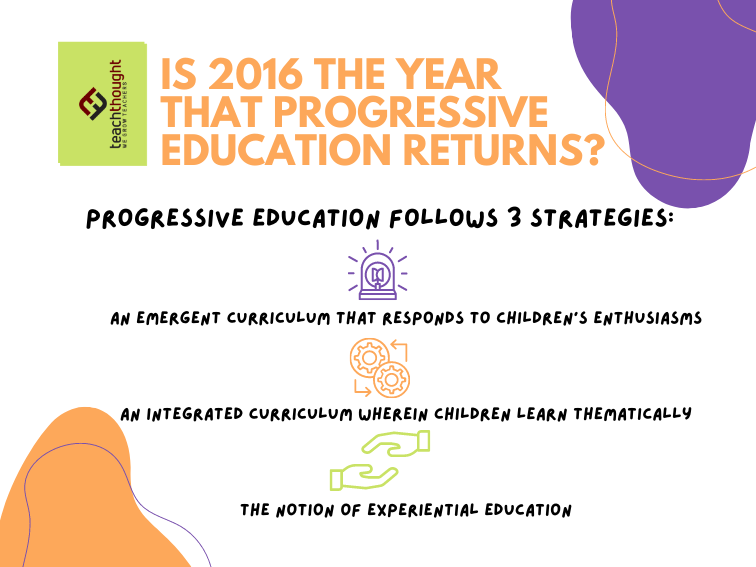Is 2016 The Year That Progressive Education Returns?
Developed in response to rigid 19th century industrial society pedagogy, progressive education sought to break the mold.

2016 Could Be The Year That Progressive Education Returns
by Robert Sun
The 1920’s were a high point in the Progressive Education movement. Developed in response to the rigid pedagogy of 19th Century industrial society—methods that stressed uniform learning largely defined by social class—Progressive Education sought to break the mold with a more enlightened approach to public schooling.
While Progressive Education had many elements, it essentially followed three teaching strategies. First was an emergent curriculum that responded to children’s enthusiasms, recognizing that students are most motivated to learn something they are already interested in. Second was an integrated curriculum wherein children learn thematically, rather than through compartmentalized subject matter. Third was the notion of experiential education, learning by doing. Experiential education requires students to get out of their chairs, work with their hands, and actively cooperate with others on a shared goal.
Despite its promise and a number of early successes, Progressive Education eventually lost momentum in the United States. Much of decline was due to the cultural conservatism of the 1940’s and 50’s, a time when national identity was highly valued and common approaches to things like education were emphasized. In that era, a good citizen was one who fit into “the system.” The ensuing Cold War caused political and educational leaders to stress outcomes rather than process—a philosophy that in many ways persists today.
As America comes to grips with the 21st Century world, however, the precepts of Progressive Education are once again finding favor. Why? Mainly because the human skills needed in this century are very different from those in the last. A recent World Economic Forum research study, “New Vision for Education: Unlocking the Potential of Technology,” identified the skills and traits students will need for future success including critical thinking, creativity, communications, curiosity, initiative, persistence and adaptability. These skills, the report states, will be as important as language arts, mathematics and science.
Progressive Education also mirrors the priorities of contemporary American society—the need to accept diversity—particularly an individual’s skills, preferences, responsibilities and rights. It values socially-engaged thinkers who can evaluate complex issues and come to independent conclusions that benefit the common good.
As much as this modern version of Progressive Education owes its existence to innovators of long ago, it has been re-shaped by 21st Century instructional thinking:
- Emergent curriculum has become Passion-Based Learning, so that skills are tailored to contemporary interests.
- Integrated curriculum is now known as Theme-Based Learning, using topics that not only activate a diverse array of subjects, but also allow students to see how each plays its part in solving a larger challenge.
- Experiential education has been enabled—even transformed—by technology that gives kids hands-on, interactive knowledge. Through creative use of technology, critical thinking, persistence, communication and collaboration are all enabled.
Finland has been a leader in the neo-progressive movement. Music, physical education and art are not only required but prized, as is time for self-directed activities throughout the school day. Finnish schools are shifting to teaching by topic rather than subject; moreover, students are free to choose topics that can span a number of traditional “subjects.” Both Finland and U.S. score in the top 10 in the 2015 Global Innovation Index, but Finland ranks 12th in the PISA study (mean score) of performance in mathematics, reading and science, while U.S. is 36th—indicating that a progressive strategy can achieve both the foundational and “soft” skills needed for success in this century.
Technology is playing a major role in the re-examination of Progressive Education. Game-based learning programs are becoming highly valued at elementary and intermediate levels because they’re child-centered and playful, allowing kids to explore complex subjects at will. Games support collaboration and the free exchange of views and ideas. Used in conjunction with interactive white boards and touchscreens, students work together to propose solutions, explain ideas, and engage in close cooperation to acquire knowledge.
Today’s form of experiential education is often referred as “project-based learning.” A similar, though shorter-format version is “program-based learning” in which students are focused on specific challenges. Game-based learning excels at these program-based situations because they allow students to grow comfortable in their new roles as collaborators. Soon they can move on to larger, project-based initiatives.
One need only look at the state of education in the U.S. today to realize people are looking for answers. The pushback over high-stakes testing isn’t abating; in New York state alone, 20% of all public school students—more than 200,000 in all—have opted out of such tests. In Pennsylvania the opt-out movement has grown by more than 300%.
As a nation, we need to take advantage of each child’s innate passion for learning, but as long as school districts see compliance as a number-one priority, they can never properly support and nurture students. Without a more enlightened approach to education, we’re viewing our children through a mere single lens.
It is important that we look at the bigger picture and find new ways to motivate our children to master skills on their own. Progressive Education, as a philosophy for improving our schools, has been debated for more than a century. Hopefully this is the year that we will finally embrace it and bring a sense of joy to learning.
ROBERT SUN is the CEO of Suntex International and inventor of First In Math, an online program designed for deep practice in mathematics.